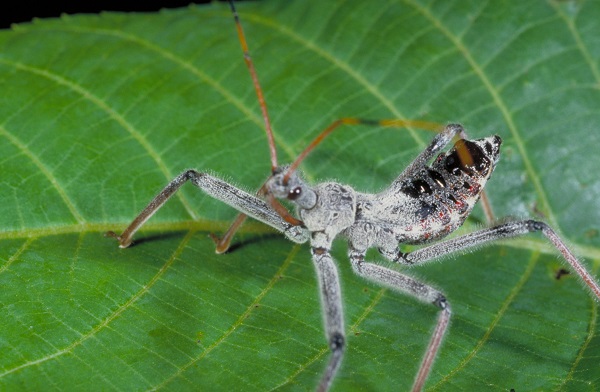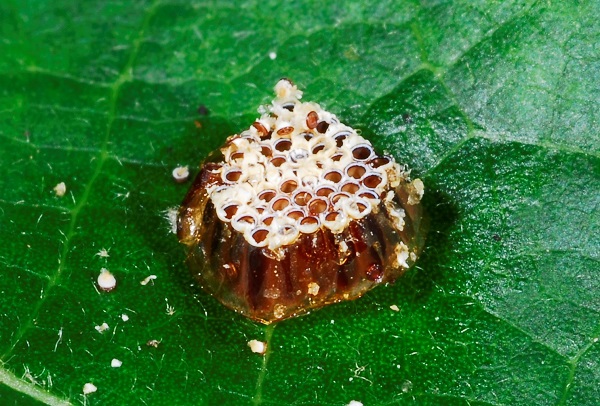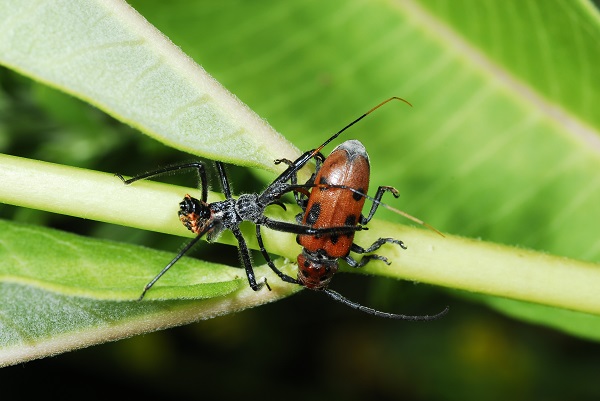The Wheel Bug
ENTFACT-705: The Wheel Bug | Download PDF
by Ric Bessin, Extension Entomologist
University of Kentucky College of Agriculture
One of the more unusual insects in Kentucky is the wheel bug(Arilus cristatus L.). This large insect is frequently seen in late summer and fall in residential areas, parks, and other outdoor settings. While this insect is common throughout the year, it is the large impressive adult stage that catches peoples’ attention. Adult wheel bugs are commonly attracted to lights at night near wooded areas, not necessarily due to the light, but rather by the presence of others insects.
Identification
The wheel bug is a large insect (1 to 1-1/2 inches in length) found in meadows, on trees and shrubs, and occasionally on buildings throughout Kentucky. It gets its common name from the shape of a prominent cog-like toothed wheel emerging from the top of the thorax. Their mouthparts are beak like and held prominently from the front of their head resembling to the trunk of an elephant. When disturbed, the adults can push out a bright orange scent gland from their rear end. The body color varies from gray to brown with brown antennae. The small nymphs are red and black, but later instars appear gray like the adults. The nymphs do not have the cog-like ‘wheel’ on their thorax.
Figure 1. This insect gets its name from the shape of its thorax.
Figure 2.Wheel bug nymphs can be recognized but their short wing pads.
Life Cycle
In the fall, the female wheel bug lays her eggs on small twigs of shrubs and trees. There are several dozen of these barrel-shaped eggs laid on end in and glued together in a cluster. In the early spring, the eggs hatch and small red and black nymphs with long legs disperse onto surrounding trees and shrubs. They have gradual metamorphosis progressing through 5 nymphal instars in the spring and early summer. Adults are common from mid-summer through the fall.
Figure 3. Wheel bug eggs are laid on end and glue together in clusters.
Ecosystem Services
The wheel bug is a true bug and has a stout beak that it uses to feed. Wheel bugs have prominent and stout piercing-sucking mouthparts. It belongs to a group of bugs called the assassin bugs and this species is the largest of the assassin bugs in Kentucky. This insect is a predator that feed on caterpillars, moths, and other soft bodied insects. The raptorial front legs are enlarged and used to seize and hold its victims. The wheel bug then inserts its beak into its prey to inject digestive enzymes and then drain the body fluids. These insects are considered beneficial in the garden and wooded areas, as they reduce the numbers of some insect pests.
Figure 4. An early-stage nymph attacking a milkweed longhorned beetle.
At first sight wheel bugs appear to be a dangerous insect because of their size and weird appearance. But it is not aggressive and will try to avoid contact. However, if handled the wheel bug will try to bite. The author notes that the bite is painful, with the sensation lasting several minutes.
Issued: 7/96
Revised: 8/22
CAUTION! Pesticide recommendations in this publication are registered for use in Kentucky, USA ONLY! The use of some products may not be legal in your state or country. Please check with your local county agent or regulatory official before using any pesticide mentioned in this publication.
Of course, ALWAYS READ AND FOLLOW LABEL DIRECTIONS FOR SAFE USE OF ANY PESTICIDE!
Photos: Ric Bessin, University of Kentucky Entomology




